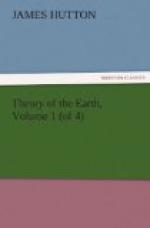I shall now give an example of this fallaceous manner of reasoning; it is in the case of certain mineral appearances which are erroneously considered as stalactical concretions.
The only true stalactical bodies are of a calcareous substance; they are formed by water containing this substance in a dissolved state; and the principles upon which this particular concretion is formed are well known. It is therefore easy to compare other concretions, which may have some superficial resemblance to these stalactical bodies, in order to see if they have proceeded upon the same principle of concretion from a dissolved state, or by water depositing its dissolved substance in a similar manner.
There are two different mineral substances which give appearances of this sort. These are certain concretions of calcedony, and also of iron-ore, which are thought to have such resemblance to stalactical concretions as, by some superficial observers, to be reckoned of the same kind. It is now proposed to show that those conclusions are not well founded; and that, in this case of calcedony and iron-ore, it could not be upon the principle of stalactical concretion that the bodies now in question had their forms.
The principle upon which calcareous substance is dissolved in water, and made to concrete by the evaporation of the acid substance, or fixed air by which it had been dissolved, is too well known to require any explanation in this place; we are only to consider the sensible effects of those operations of which we know so well the proper conditions.
There are just two distinct views under which we may consider all stalactical concretions formed; these are the incrustation of the calcareous substance concreting upon a foreign body, and the incrustation of the same substance upon itself. By the first any manner of shape may be formed, provided there be a solid body, upon the surface of which the calcareous solution is made to pass. By the second, again, we have various forms; but we know the principles upon which they had been made. These are the shape and motions of the fluid which gives the calcareous concretion. Now, these principles are always to be perceived, more or less, in all the bizarre or fantastical, as well as regular shapes which are produced by stalactical concretions. At present, we shall confine our views to one particular shape, which is simple, regular, and perfectly understood wherever it is formed.
Drops of water falling from a roof, and forming stalactite, produce first tubular bodies, and then gradually consolidate and increase those pendulous bodies by incrustation. These appearances are thought to be observed in the calcedony and ferruginous concretions, which has led some mineralists to conclude, that those concretions had been formed in the same manner, by means of water. We are now to show that these mineral appearances are not analogous to stalactites in their formation, and that they have evidently been formed in a different manner.




